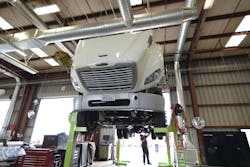Primary factors speeding the adoption of natural gas vehicles
While obstacles for companies that want to adopt natural gas vehicles into their fleet are still present, new developments in fueling infrastructure, engine technologies and maintenance facilities have helped companies make the jump to cleaner fleet operations.
One predominant challenge for commercial fleets continues to be the lack of existing infrastructure to support fueling for natural gas vehicles. There are currently about 1,000 compressed natural gas fuel stations in the U.S., but only a small percentage are configured for heavy duty vehicles.
However, with more investments from the energy industry and even the private sector, there is an increase in the number of natural gas fuel stations for commercial fleets and that momentum is expected to continue. Collaboration between the public and private sector is helping to drive this trend.
NEW ENGINE TECHNOLOGIES
There have also been a few significant developments in new engine technologies over the past few years that are helping speed the adoption of natural gas. While the vehicle portfolio is still limited, it continues to evolve. All major chassis manufacturers currently have a natural gas product offering, which in itself is a significant milestone.
The new Cummins 12-liter natural gas engine, which Ryder has been testing in its fleet for over a year now, has a broader range of applications for customers who have not yet been able to take advantage of natural gas vehicle technology. Other companies are developing dual fuel technologies for retrofit applications that also provide a good bridge for fleets that aren’t able to pay the premium for a new natural gas truck.
OVERLOOKED NECESSARY ELEMENT
One of the most critical elements for a successful natural gas fleet operation that is often overlooked is maintenance.
Traditional shops must go through a modification process to meet stringent industry and government safety standards for natural gas vehicle maintenance. This includes upgrades to electrical and ventilation systems and the installation of methane detection systems.
In addition, professional technicians must receive extensive, specialized training on the maintenance and repair of heavy duty natural gas vehicles, as well as safety protocols that must be followed when natural gas vehicles are in the shops.
Fleet managers should also become familiar with government incentives related to natural gas. Knowledge of rebates and tax incentives is extremely important to any business considering an investment in natural gas.
The U.S. Department of Energy has detailed information on its Alternative Fuels & Advanced Vehicles Data Center website, www.afdc.energy.gov/afdc/laws/. Click on the “Incentives & Laws” tab to search for information by state.
Scott Perry is the vice president of supply management for Ryder System (www.ryder.com), a leading transportation and supply chain management solutions company. He is responsible for managing vehicle and parts procurement, inventory planning and management and new vehicle technologies, as well as overseeing Ryder’s alternative fuel program. Ryder currently has natural gas vehicle solutions and maintenance capabilities in California, Arizona, Michigan, New York, Louisiana, and Texas, including two liquefied-to-compressed natural gas fuel stations in Orange and Fontana, Calif.
